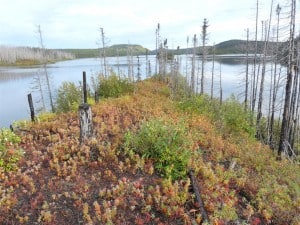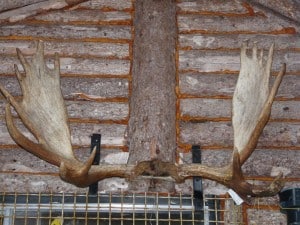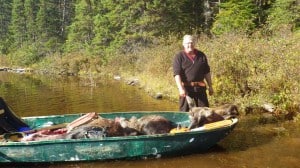Moose hunt postmortem – Bull with the heart of lion enters hunt camp lore; why hunters aren’t engaged in climate change battle
One of my reasons for taking part in a Moose hunt in northern Quebec this fall was to better understand why my friend, Raynald Pilon, has an almost obsessive love of Moose hunting. I was also interested in how he and other hunters feel about the future of “la chasse” and why there isn’t more of an outcry against the threat of climate change to our hunting and fishing heritage.
During several of our memorable meals, I took some time to ask both Raynald and his hunting partner, Claude Moisan, why they are so passionate about Moose hunting. The reasons they gave were many. Naturally, they mentionned the beautiful landscapes, the solitude, the camaraderie and the joy of simply getting away from everything. They also talked about the pleasure of returning year after year to the same hunting territory and really getting to know it intimately – everything from the specific habitats and locations the Moose frequent to the types of plants they eat. They also impressed upon me once again that the world of the Moose is incredibly complex and, to be a successful, a hunter needs to acquire many different skills. One of the most challenging is learning to reproduce the many sounds that Moose make and using them in the right context. Therefore, when your skills, patience and experience all come together and result in a successful hunt, there is a huge sense of satisfaction. The actual shooting and killing of the animal is only a tiny part of the whole.
Raynald also made the important point that Moose meat is wonderful. Not only is it a lean, but you would almost think you are eating a tender cut of beef. He explained that the quality of the meat depends to a large degree on following the correct procedures after the animal is killed. This is when the hard work begins. The carcass needs to be bled, emptied of internal organs and quartered as soon as possible. The quarters then have to be cooled down by providing as much air flow as possible around the meat. If they make a kill late in the day or far from the camp, Raynald and Claude often build a platform from small tree trunks for this purpose. The quarters are then placed on the platform. A day or two later, they bring them back to camp by boat or ATV to hang in a meat house they have constructed. The quarters are then flown out by float plane and prepared by a butcher.
Richard the Lionhearted
As you can well imagine, Raynald and Claude have intense, detailed memories of hunts past, including how they found each animal, killed it, retrieved the meat and even named it. The prospect of experiencing new, equally-memorable adventures is therefore a big part of why they return each year.
Maybe the most remarkable story they told me was about a bull they called Richard the Lionhearted. Named both for its “heart” (i.e., never giving up) and the atypical, almost lion-like grunting sounds it made, they first encountered Richard in 1991. Unfortunately for Richard, they had just killed the cow that he was courting. As they paddled up to the shore where the cow lay – it was already dark by this time – they were startled by loud, unmoose-like grunts emanating out of the darkness right beside them. Claude remembers the hair on the back of his neck literally standing on end. The banging and splashing of the animal’s hooves on the rocks in the shallow water spoke volumes of its imposing size. Standing just metres away in the glare of the flashlight, this was one mad Moose. Raynald thought the animal was going to charge the canoe at any second. Only after they started yelling and banging paddles did the enraged Moose reluctantly retreat.
The following autumn, they came across Richard once again. Raynald heard the bull’s distinctive grunts coming from high on a hill. He managed to approach the animal and found it “talking” back and forth with a cow. However, the two Moose took off before he could get a shot. About a week later, while paddling to one of the blinds, he heard and saw them again. This time Raynald was able to take a clear shot, and the bull appeared to drop to the ground. However, being a neophyte hunter and wanting to get help, he paddled down the lake and got Claude. When they arrived back, the Moose was no where to be seen. Naturally, they began looking for it. Claude walked along the shoreline, while Raynald took a parallel route further up the hill. Claude was the first to see the injured Moose and shot at it from behind. Raynald, hearing the shot, looked down the hill and saw it standing motionless. He, too, took a shot, and the bull collapsed to the ground. Without thinking, the two of them ran up to the animal, put down their rifles and hugged each other in celebration. This is not something they would ever do again. All of a sudden, the never-say-die bull sprang to its feet and bolted through heavy bush out into the shallow water of the bay. Despite the heavy dose of adrenaline coursing through his veins, Raynald somehow managed to get off a shot but Richard kept on going. Only when he stumbled out of the water on the far shore did a fifth and final bullet bring him down for good. As you can well imagine, they haven’t come up against a mightier, tenacious Moose since. Readers should note that this type of hunting scenario is very rare. Usually, only one or two shots are sufficient to kill a Moose and any suffering is minimal. In fact, death at the hands of a hunter is probably more humane than how these animals usually die, namely from disease, starvation or a predator.
Future of hunting
I also talked to Raynald and Claude about what concerns them most with regard to the future of hunting. Clearly, their biggest worry is the lack of recruitment of young people. They both told me that even their own children are only mildly interested. Not only does this bode poorly for the future of hunting but also for the future of the wildlife and wildlands that hunting organizations help to maintain.
I also brought up something that has bothered me for years. Why doesn’t the hunting and angling community speak out more forcefully when it comes to the issue of climate change? I’m not sure that my friends could really answer this question other than to say that hunters tend to be very individualistic and are not big fans of government intervention and regulations. A couple of days ago, I talked to Dawn Suce, a biologist at the Ontario Federation of Anglers and Hunters (OFAH) about this concern. She explained to me that OFAH representatives do indeed sit on numerous provincial committees that work to promote biodiversity and adaptation to a changing climate. She also spoke about the many “on the ground” conservation initiatives that the organization carries out. As commendable as this is, what I find lacking are strong public pronouncements and lobbying by organizations like OFAH about the crucial importance of reducing greenhouse gas emissions. I would have thought that hunters and anglers themselves would be demanding action in this regard simply out of their own self-interest. Climate change is posed to transform the face of hunting and fishing utterly and entirely. To give just one example, Moose populations across the southern part of their range (e.g., Manitoba, New Hampshire, Minnesota) are plummeting as a result of winter tick infestations. Many biologists believe that this phenomenon is almost certainly linked to a warming climate. If hunters only realized that politicians, especially at the federal level, are selling them out and putting their hunting and angling heritage at risk – as well as their children’s future – they would be screaming from the rooftops for action.
Some of you may be asking yourself whether we ended up getting a Moose this fall. The answer is yes, but 24 hours after I left! Raynald shot a cow not far from one of the blinds where I had spent an entire day. As much as I regret having not been there to see all that happens after a kill, at least I dodged the existential crisis of having a Moose present itself in front of me and forcing me to decide “do I shoot or not?”
More pictures of the Moose hunt can be seen in the Photos section of this website.


